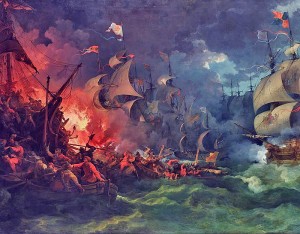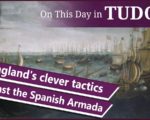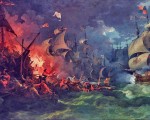
Defeat of the Spanish Armada at Gravelines, Philipp Jakob Loutherbourg the Younger.
On 29th July 1588, the day after the English had wrecked the crescent formation of the Spanish Armada at Calais with five hell-burners (fire-ships)and caused havoc, they attacked the Spanish fleet. This battle is known as the Battle of Gravelines because it took place just off the port of Gravelines, a Spanish stronghold in Flanders, part of the Spanish Netherlands, but near the border with France. The Duke of Medina Sedonia had been unable to reform the Spanish fleet at Calais, due to a south-easterly wind, and was forced to regroup at Gravelines.
The English had learned from previous encounters with the Spanish fleet and so used new and more successful tactics. They had learned from capturing the Rosario in the Channel that the Spaniards could not easily reload their guns, so with their smaller and lighter ships the English were able to provoke the Spaniards into firing, but keep out of range and then close in for the kill.
[Read More...]





